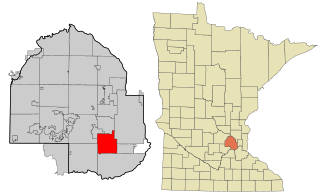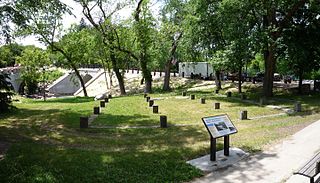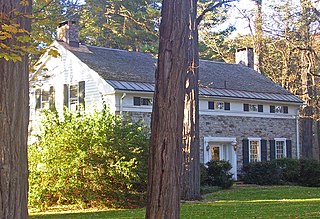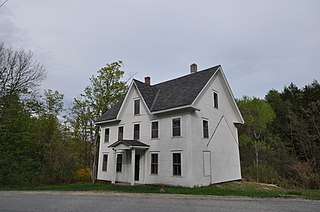
Edina is a city in Hennepin County, Minnesota, United States and a first-ring suburb of Minneapolis. Edina began as a small farming and milling community along Minnehaha Creek in the 1860s and became one of Minneapolis's first incorporated suburbs in 1888. In 2019, the population was estimated to be 52,857.

Morningside is a distinct geographical and architectural neighborhood in Edina, Minnesota. Morningside is an old streetcar suburb adjacent to Minneapolis' Linden Hills neighborhood.

The Edina Mill was one of the first of six gristmills to be built on the Minnehaha Creek in Hennepin County, Minnesota between 1855 and 1876. Located in present-day Edina, the mill site was discovered during an expedition from Fort Snelling to Lake Minnetonka in 1822. Although the original mill structure was demolished in 1932, its former site is preserved with foundation markers and informational exhibits.
The Edina School District is the public school system for most of the city of Edina, Minnesota. It is also referred to as the Independent School District (ISD) 273. There are approximately 8,500 students, K-12, served by 1139 teachers and support staff in six elementary schools, two middle schools and one high school.

Windmill Hill is an historic house on Windmill Hill Road in Dublin, New Hampshire. Built in 1934, it is a fine example of Colonial Revival architecture, built as a summer house in the style of a traditional New England farmhouse. The house was listed on the National Register of Historic Places in 1983.

The George W. Baird House is a house in Edina, Minnesota, United States, built in 1886 by a prominent farmer in the Edina Mills community. The house was originally part of a 120-acre (49 ha) farmstead. The house was listed on the National Register of Historic Places in 1980 for having local significance in architecture, agriculture, and settlement.

The Gale–Banks House is a historic house at 935 Main Street in Waltham, Massachusetts. This farmhouse was built c. 1798, and is one of the finest Federal style houses in the city. It is also significant for its association with Waltham native son, Governor of Massachusetts, and general of the American Civil War, Nathaniel Prentice Banks, who purchased it in 1855 and made it is home until his death in 1894. The house was listed on the National Register of Historic Places in 1990.

The Broom-Braden Stone House is a historic residence located near the city of Cambridge in Guernsey County, Ohio, United States. Home to a prominent early citizen of the area, it is one of Guernsey County's best early houses still in existence, and it has been named a historic site.

The Glenville School is a historic school building at 449 Pemberwick Road in the Glenville section of Greenwich, Connecticut, United States. It was listed on the National Register of Historic Places in 2003. It was one of several schools built in the town in the 1920s, when it consolidated its former rural school districts into a modern school system, with modern buildings.
Grimes House may refer to:

The Dirck Westbrook Stone House is located on Old Whitfield Road near the hamlet of Kerhonkson in the Town of Rochester, New York, United States. It is a stone structure that dates in part to the early 18th century.

The Storm–Adriance–Brinckerhoff House is located on Beekman Road in East Fishkill, New York, United States. It is a wooden building in three parts, the oldest of which dates to the mid-18th century.

The Ole Carlson House is a historic farmhouse in Dodge County, Minnesota. Located in Canisteo Township, it is on County Road 15, approximately 8 miles (13 km) south of Kasson, Minnesota. In 1981, the home remained in the ownership of the grandson and great-grandson of Ole Carlson. The private home was placed on the National Register of Historic Places (NRHP) on April 16, 1982.

Botany Bay Plantation Wildlife Management Area is a state preserve on Edisto Island, South Carolina. Botany Bay Plantation was formed in the 1930s from the merger of the Colonial-era Sea Cloud Plantation and Bleak Hall Plantation. In 1977, it was bequeathed to the state as a wildlife preserve; it was opened to the public in 2008. The preserve includes a number of registered historic sites, including two listed in the National Register of Historic Places: a set of three surviving 1840s outbuildings from Bleak Hall Plantation, and the prehistoric Fig Island shell rings.

The Acre is a historic house at the corner of Main Street and Dublin Road in Harrisville, New Hampshire. Built about 1880 by the Cheshire Mill Company, it is a good example of period worker housing constructed by the company for itinerant workers. The house was listed on the National Register of Historic Places in 1988.

Smith Chapel is a historic memorial chapel at 45 Mill Pond Road in Durham, New Hampshire, United States. Built in 1900 in the family cemetery of the locally prominent Smith family, it is a prominent local example of Late Gothic Revival architecture. It is now part of a small municipal park. The chapel was listed on the National Register of Historic Places in February 2013, and the New Hampshire State Register of Historic Places in April 2013.

The George Johnson House is an historic building located near Calamus, Iowa, United States. It was listed on the National Register of Historic Places in 2000.

The Charles Spangenberg Farmstead is a historic farm in Woodbury, Minnesota, United States, established in 1869. The three oldest buildings, including an 1871 farmhouse, were listed together on the National Register of Historic Places in 1978 for having local significance in the theme of agriculture. The property was nominated for being one of Washington County's few remaining 19th-century farmsteads.

The John & Mary Elizabeth Booth Endicott House is a private house located at 290 Chesterfield in Bloomfield Hills, Michigan. It was listed on the National Register of Historic Places in 2008.

The Davis Carriage House is a single family home located at 519 N. Fayette in Saginaw, Michigan. It was listed on the National Register of Historic Places in 1982.




















